Selecting the right ecommerce platform is crucial for the success of your dropshipping business. With numerous options available, understanding which platforms offer the best features, pricing, and support can be challenging. This guide explores the top ecommerce platforms for dropshipping in 2023, helping you make an informed decision for your ecommerce store.
Key Factors in Choosing an Ecommerce Platform for Dropshipping

When selecting an ecommerce platform for dropshipping, consider these critical factors:
- Ease of Use: An intuitive interface simplifies store management, allowing you to focus on growing your business.
- Setup Time: A quick setup process enables you to launch your ecommerce store promptly.
- Dropshipping Supplier Integrations: Seamless integration with suppliers streamlines operations, from product listing to order fulfillment.
- Design and Customization Features: Robust design tools help create a unique and engaging shopping experience.
- Built-in Marketing Tools: Features like SEO optimization, email marketing, and social media integration enhance visibility and attract customers.
- Pricing: Assess subscription fees, transaction costs, and additional charges to maintain a healthy budget.
Fully Hosted vs. Self-Hosted Platforms
Ecommerce platforms generally fall into two categories:
Fully Hosted Platforms:
- Pros: Easy setup, managed technical aspects, quick launch.
- Cons: Less flexibility, potentially higher long-term costs.
Self-Hosted Platforms:
- Pros: Full control over source code, lower long-term costs, infinite customization.
- Cons: Requires technical knowledge, responsible for hosting and maintenance.
Top Ecommerce Platforms for Dropshipping
1. Shopify
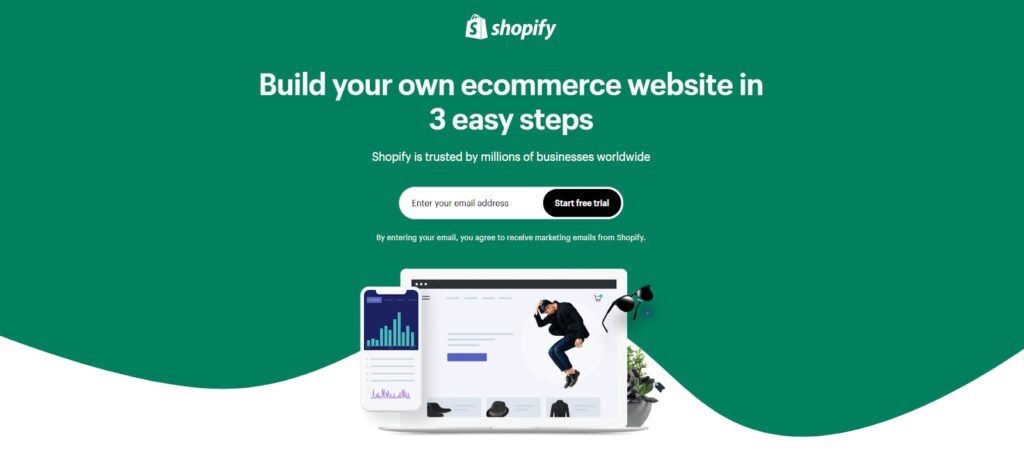
Image Source: shopify.com
Shopify has established itself as a leading ecommerce platform, boasting over 1.75 million businesses across 175 countries. Renowned for its user-friendly interface and extensive customization options, the platform caters to both beginners and experienced merchants alike.
Pros:
- User-friendly interface: Intuitive design, ideal for beginners.
- Extensive app marketplace: Offers a wide range of plugins for customization and functionality.
- Robust integration with dropshipping suppliers: Includes seamless integration with services like Printful.
- Reliable customer support: 24/7 support through different channels.
Cons:
- Transaction fees: Additional charges apply if not using Shopify Payments.
- Limited free templates: Premium templates can be costly (starting at $140).
- Scalability costs: Higher-tier plans can be expensive for small businesses.
Pricing:
Shopify offers a tiered structure to cater to businesses of different sizes. The basic plan costs $39/month, providing all the essential features needed to start a small online store. There are no transaction fees if you’re using Shopify Payments. If you choose third-party payment providers, there will be an additional fee per payment based on your subscription: 2% for the Basic plan, 1% for the Shopify plan, and 0.5% for the Advanced plan.
2. WooCommerce
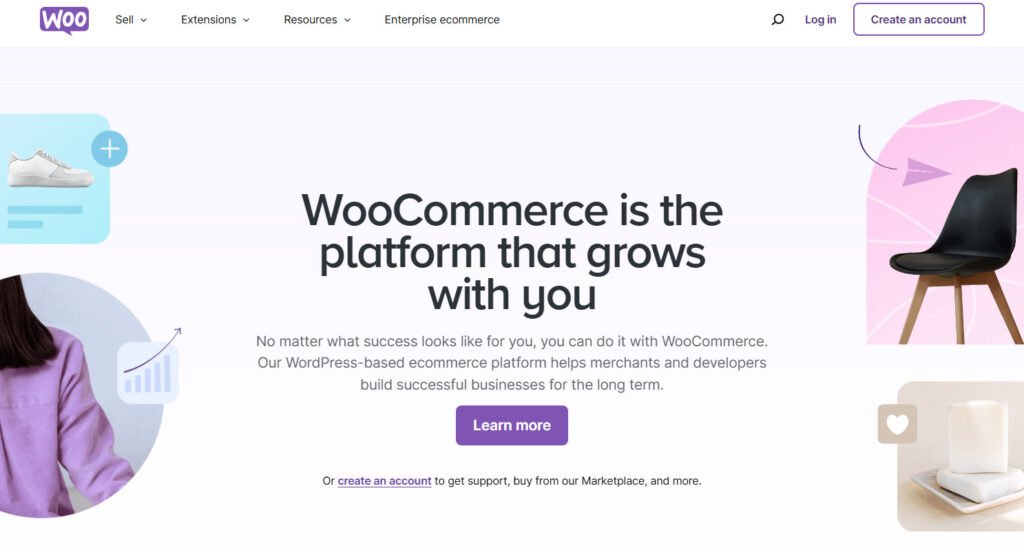
Image Source: woocommerce.com
WooCommerce is a free plugin for WordPress that can also be considered an ecommerce software platform. In 2023, the WooCommerce marketplace dominated, owning 39% of the market shares. Building a dropshipping store with WooCommerce is particularly appealing to brands with a WordPress website who want to expand into ecommerce.
Pros:
- High customizability: Extensive options for customization and scalability.
- WordPress integration: Seamless integration with existing WordPress sites.
- Large plugin ecosystem: Access to a wide range of WordPress plugins and themes.
- No initial costs: Being a free plugin, it’s accessible for businesses starting out.
Cons:
- Requires WordPress: Limited to WordPress users.
- Some technical know-how needed: More suitable for those with some technical background.
Pricing:
While WooCommerce itself is free, running an ecommerce store on this platform may incur various costs, such as web hosting, extra security, payment gateways, and additional plugins or themes. The total cost of selling on WooCommerce varies depending on your choices in hosting and add-ons. However, this pay-for-what-you-need model allows flexibility, especially for small to medium-sized businesses looking to control costs while growing their online presence.
3. BigCommerce
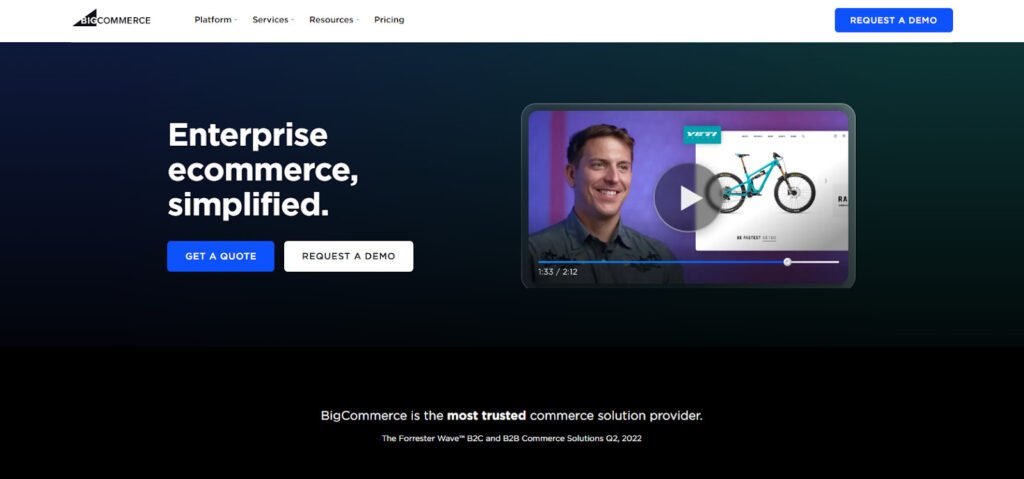
Image Source: bigcommerce.com
BigCommerce is special for its exceptional scalability, making it ideal for businesses aiming to grow. It’s also well-known for its extensive built-in features, reducing the need for external apps.
Pros:
- Scalability: Supports businesses as they grow, handling large product catalogs and high traffic volumes.
- Built-in features: Offers a wide range of features out-of-the-box, reducing reliance on third-party apps.
- No transaction fees: Allows you to keep more of your profits.
Cons:
- Revenue-based pricing model: Plans are based on your annual sales, which can be problematic for dropshipping businesses with thin margins.
- Limited free themes: Premium themes can be expensive.
Pricing:
BigCommerce offers a tiered pricing structure based on your annual sales. The Standard plan starts at $39/month, allowing up to $50k in online sales per year. As your sales increase, you’ll need to upgrade to higher-tier plans, which can be costly for businesses with thin margins.
4. Wix
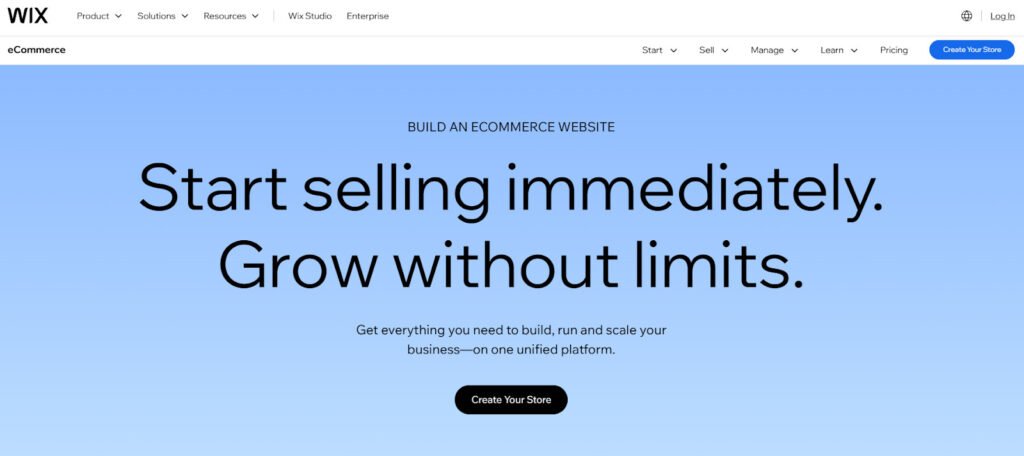
Image Source: wix.com
Wix is a cloud-based website builder that’s designed for users without any technical knowledge or coding background. It allows you to create an ecommerce website using a simple drag-and-drop interface and offers customizable templates.
Pros:
- User-friendly: Ideal for beginners with no coding experience.
- Affordable: Entry-level plans are budget-friendly, making it accessible for small businesses.
- All-in-One Solution: Includes hosting, design tools, and basic SEO features.
Cons:
- Limited Scalability: Wix is better suited for small businesses and may not support larger, high-traffic ecommerce stores effectively.
- Lacks Dropshipping Features: Does not offer seamless integration with popular dropshipping suppliers like Printful or Oberlo.
- Restricted Customization: Customization options are more limited compared to platforms like Shopify or WooCommerce.
Pricing:
Wix offers plans starting at $27/month for ecommerce, making it one of the more affordable options for small ecommerce stores. However, as your store grows, you may need to invest in additional features, potentially increasing costs over time.
5. Square Online
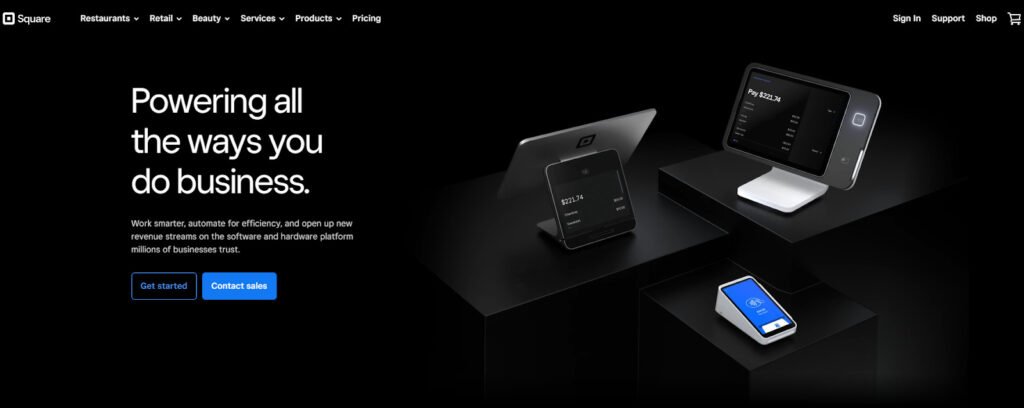
Image Source: squareup.co
Square Online is an excellent choice for small business owners, especially those already using Square’s point-of-sale (POS) system. It seamlessly integrates in-person and online sales, making it convenient for businesses looking to expand into ecommerce.
Pros:
- Free Plan Available: Ideal for startups with limited budgets.
- POS Integration: Syncs perfectly with Square’s in-person POS system.
- Ease of Use: Simple setup and intuitive dashboard.
Cons:
- Limited Advanced Features: Not ideal for larger businesses or advanced customization.
- Transaction Fees: A 2.9% + 30¢ fee per transaction applies unless you upgrade to premium plans.
Pricing:
Square Online offers a free plan, but premium plans with additional features start at $29/month. The affordable pricing and POS integration make it an attractive option for small-scale ecommerce companies.
Platforms That May Not Be Ideal for Dropshipping
While numerous platforms offer versatile features for e-commerce, not all are perfectly tailored to the unique needs of dropshipping. Here are a few platforms that might pose challenges for dropshipping businesses and considerations to keep in mind:
1. Magento

Image Source: business.adobe.com
Magento is a powerful platform designed for enterprise-level businesses. However, its complexity and high setup costs make it impractical for most dropshipping beginners.
- Challenges: Requires technical expertise and significant financial investment in hosting and development.
2. Squarespace

Image Source: squarespace.com
Squarespace is renowned for its visually stunning templates but lacks robust tools for ecommerce services, especially in dropshipping.
- Limitations: No direct integration with suppliers, fewer marketing features, and a lack of scalability for ecommerce stores.
How to Choose the Best Ecommerce Platform for Your Dropshipping Business
When deciding on a platform, ask yourself the following questions:
- How tech-savvy are you?
- Do you prefer a hosted or self-hosted solution?
- What is your budget for subscription fees, apps, and additional services?
- Do you need advanced integrations with dropshipping suppliers?
Recommendations:
- For Beginners: Shopify offers simplicity, extensive resources, and excellent support for scaling up.
- For Budget-Conscious Sellers: WooCommerce is a cost-effective option with unmatched customization.
- For U.S.-Based Merchants: Shift4Shop is a strong contender, offering free plans for eligible users.
- For Small Businesses: Square Online combines affordability with ease of use.
Optimizing Your Dropshipping Store
SEO Best Practices for Ecommerce Websites:
- Use descriptive, keyword-rich titles and meta descriptions for products.
- Optimize your images with alt text and compression for faster loading speeds.
- Create blog content around your niche to drive organic traffic.
Enhance User Experience (UX):
- Ensure easy navigation with a clear menu structure.
- Include high-quality images and videos for products.
- Implement a smooth checkout process to reduce cart abandonment.
Mobile Optimization:
- Use a responsive design that adapts to all devices.
- Test your store’s loading speed on mobile to avoid slow performance.
- Streamline mobile checkout with autofill features and one-click payment options.
Marketing Your Dropshipping Store
To attract and retain customers, focus on these strategies:
1. Social Media Marketing:
- Leverage Instagram, TikTok, and Pinterest for visually engaging content.
- Partner with influencers to promote your products.
- Run targeted ads to reach your ideal audience.
2. Content Marketing:
- Write blogs around your products to improve SEO and engage readers.
- Create video tutorials or product demos.
- Share customer testimonials to build trust.
3. Email Campaigns:
- Build a subscriber list through discounts and lead magnets.
- Send personalized product recommendations.
- Share exclusive offers to encourage repeat purchases.
Final Thoughts
Choosing the right ecommerce CMS platforms is a crucial step toward building a successful dropshipping business. Each platform offers unique features, so it’s essential to align your business needs with the platform’s capabilities. For user-friendly tools and scalability, Shopify stands out as a top choice. WooCommerce offers unmatched flexibility and cost-effectiveness, especially for those with existing WordPress websites. Platforms like Square Online cater to small businesses, combining affordability with ease of use.
To further optimize your dropshipping store, ensure your product listings are visually appealing. Using the best product photo editing app, like ProductScope AI, can elevate your store’s visuals and help you stand out in a competitive market. Streamline your operations, focus on customer experience, and leverage effective marketing strategies to turn your ecommerce venture into a thriving success.
Sign Up for ProductScope AI Today!
With the right platform and tools in place, you’ll be well on your way to achieving your dropshipping goals this 2024 and beyond.

